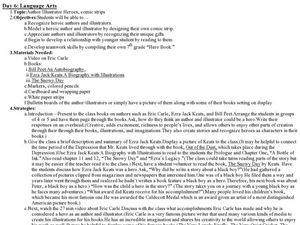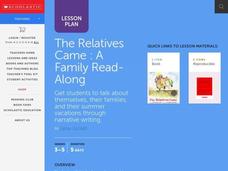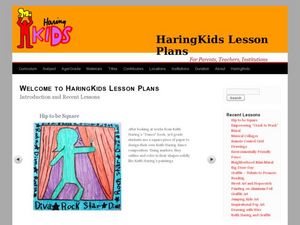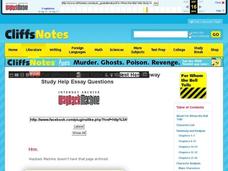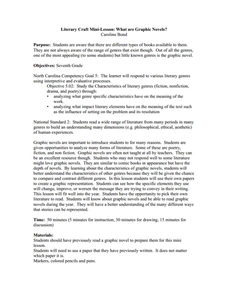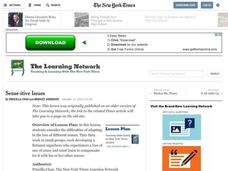Curated OER
Literature and Humor
From Canterbury Tales to The Odd Couple, this presentation details the different treatments of humor in different literary formats. Numerous authors and works of literature are represented here as examples of satire, irony, comedy, and...
Classics for Kids
Hurry Up – Slow Down
Is your music appreciation class feeling a bit adagio this afternoon? Pick up the pace and get them feeling andante with a straightforward music theory activity. After defining several terms for musical dynamics and musical tempos,...
Curated OER
Author/Illustrator Heroes
Students recognize heroic authors and illustrators and create their own comic strips. In this language arts lesson, students examine characteristics of heroes and work in groups to create their own comic strips and hero books.
Curated OER
The Relatives Came: A Family Read-Along
Students read the book, 'The Relatives Came' by Cynthia Rylant to revive memories about their own summer vacations and family customs. They write a friendly letter about a fantasy summer vacation--"What I Wish I Did on My Summer...
Curated OER
Keith Haring Lesson Series
Second graders study Keith Haring by creating tee-shirts and a mural. In this art lesson, 2nd graders study the life and works of Keith Haring through his symbols. Students then make drawings reflective of Haring's style as music plays....
Curated OER
Interative History Notebook Mini-lesson
Students respond to Holocaust literature. In this interactive history lesson, students select quotes from chapter 1 of Elie Wiesel's Night and reflect on their meaning as they record their thoughts on poetic, prose, comic. or picture form.
Curated OER
Author Study - Mo Willems
Students listen to books written by Mo Willems each day and discuss the story elements of each. In this reading strategies lesson, students decide after reading through the whole series of books, what their favorite book is and why.
Curated OER
Working With Writing
Fifth graders research a topic of their choice using the internet, magazines, and books. In this research lesson plan, 5th graders are graded on their research and delivery skills of their presentation.
Curated OER
Convincing Characters
Students create vivid, active characters for a story. In this character lesson, students discuss the characters in books they are familiar with. Students create a list of novels they have read and discuss the character types. Students...
Curated OER
My First Day of School
For this Junie B. Jones activity worksheet, learners think about their first day of school and create a comic strip using the 8 boxes to depict their day.
Curated OER
Plot Structure
Ninth graders review the parts of a plot sequence for a short story. They think of a famous Disney movie and plot the events of the movie in the correct plot sequence. They do the same for a comic strip, labeling the exposition, rising...
Curated OER
What is Manga?
Students research graphic novels. In this manga lesson, students work in small groups as the read graphic novels in literature circle format.
Khaled Hosseini Found
Lesson One: Exploration of The Kite Runner Graphic Novel
What is a graphic novel? How does it differ from a traditional novel? These questions launch a discussion of Fabio Celoni and Mirka Andolfo's graphic novel adaptation of The Kite Runner. Through a series of literature circle discussions,...
Curated OER
Glossaries
Explore text structure with a focus on the glossary feature in informational texts. Learners read a brief introduction before examining a glossary from a text about plants. They reference it while completing four comprehension questions....
Curated OER
For Whom the Bell Tolls - Essay Questions
After finishing the dense novel For Whom the Bell Tolls, have your class prepare for your unit test with this set of study questions. Consider narrowing the list down to encourage a deeper analysis of specific questions.
Appalachian State University
What Are Graphic Novels?
To do this engaging and pleasurable activity, your learners should have already read a graphic novel, and produced a piece of writing that can be reproduced into the format of a graphic novel. This exercise provides a script that...
Curated OER
A Chicken's Life
Here is a set of comprehension questions that go with the story "A Chicken's Life." Learners answer each of nine questions by filling in the blank with the correct word then, they complete ten additional comprehension questions that...
Curated OER
Quiz 6A: Verb Practice
Here is a worksheet that provides practice using English verb forms like the simple present, simple past, and present progressive. Learners fill in the blanks in 10 sentences using the given verb correctly based on context. I'd go over...
Shmoop
ELA - Literacy.CCSS.ELA-Literacy.RH.11-12.1
Understanding, analyzing, citing, linking—the four steps required by CC ELA Literacy Standard RH.11-12.1. Enjoy the humor of the explanations of these steps as you examine the suggestions for Common Core designed activities related to...
Curated OER
The Furry News: How to Make a Newspaper
Students investigate the process of making a newspaper using children's literature to create context for the lesson. The readers are asked to predict the events of the story as it is read to them. Then the teacher uses guided questions...
Curated OER
Hooray for Harry
Students examine the Harry Potter series of books and read about charitable endeavors of J.K Rowling. They explore various websites and look for newspaper articles about charitable giving or charitable service.
Curated OER
Terms of Office
Pupils use election related words to create a dictionary page for each of them. They use the internet to research the definitions of the words. They combine all of the pages and put them into a book.
Curated OER
Sense-itive Issues
Students consider the difficulties of adapting to the loss of different senses. They work in small groups, each developing a fictional superhero who experiences a loss of one of sense and must compensate for it with his or her other senses.
Curated OER
Once Upon a Time: Writing Stories about Reading
Students read a New York Times article to examine strong first person voice in essays about reading. They write their own first person essays about some aspect of reading, participate in peer review, and re-writing.




